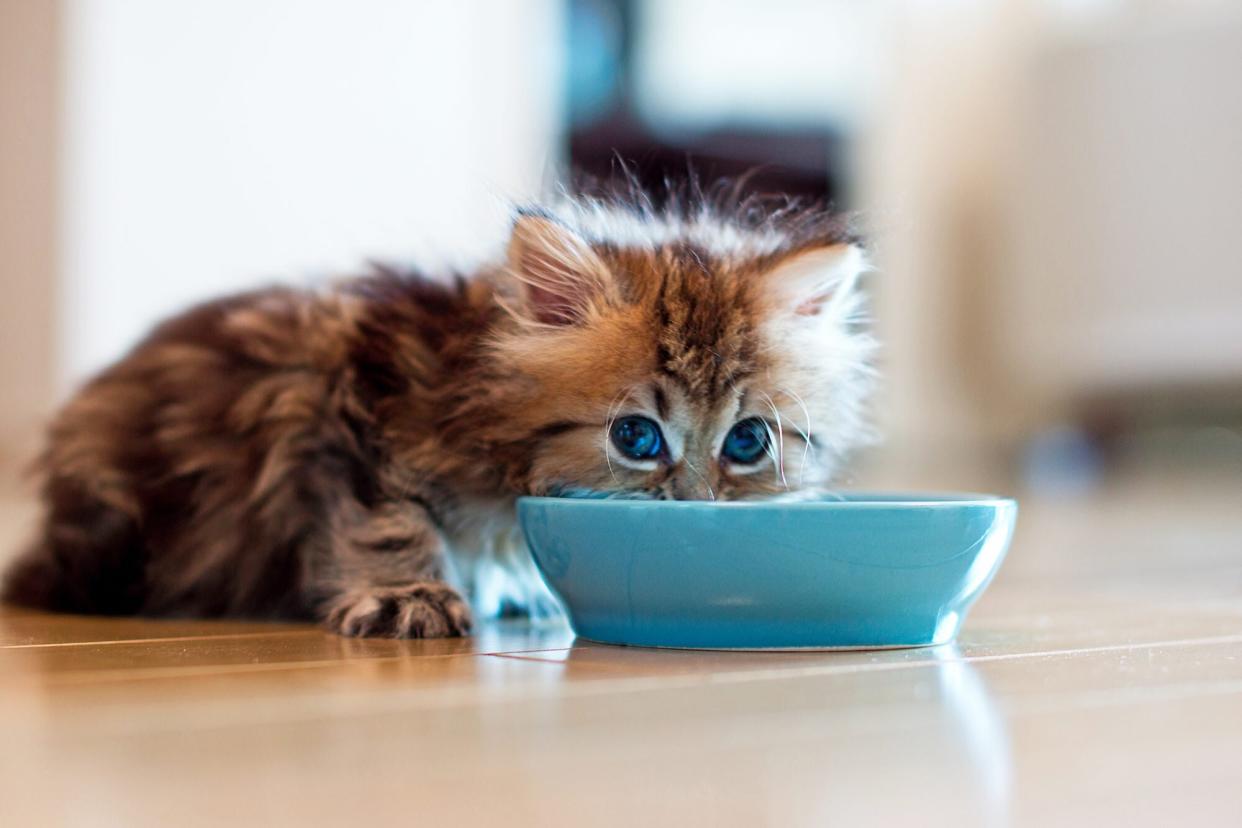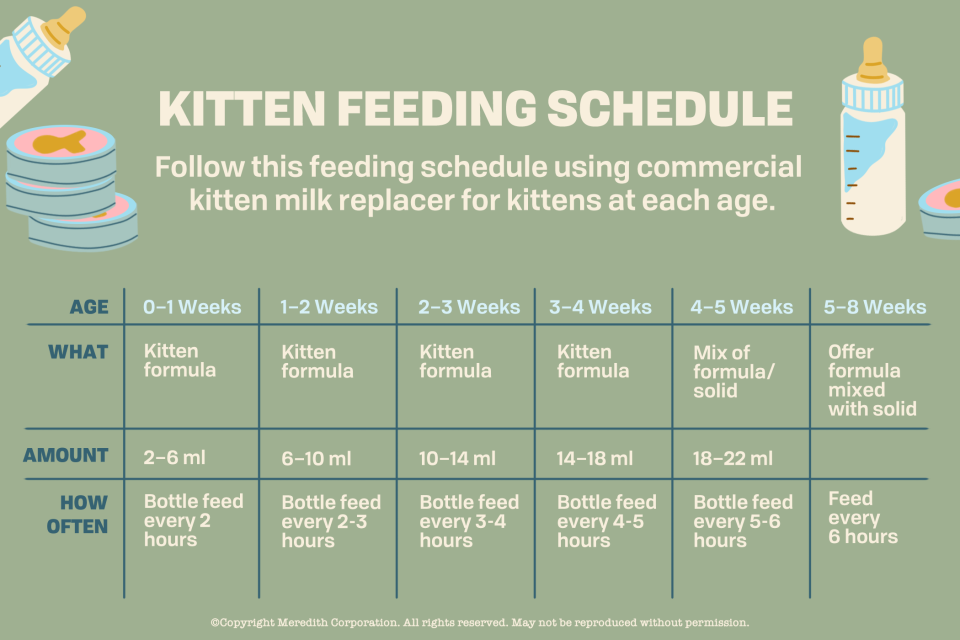When Do Kittens Start Eating Food? A Veterinarian Says Sooner Than You Might Think

Benjamin Torode / Getty
TABLE OF CONTENTS
On This Page
When Are Kittens Weaned?
What to Feed a Kitten (and How)
What Food Do Kittens Eat After Weaning?
Kittens experience rapid development, morphing from wiggly lil' furballs to spritely young cats in just a few weeks. So when do kittens start eating food? We asked Tarina L. Anthony, DVM, to help detail the weaning timeline and when cat owners can start putting out solid food for the little ones.
When Are Kittens Weaned?
"A tremendous amount of growth takes place in the first year of life, with the majority being in the first six months," Anthony, owner and medical director of Aurora Cat Hospital and Hotel in Aurora, Colo., tells Daily Paws. "During that initial half year, kittens will grow from an average birth weight of around 100 grams to around 6 pounds. In the first two weeks alone, their body weight doubles."
What do kittens eat from birth to about 4 weeks old? Exclusively mother's milk, so as a pet parent, your job is to make sure Momma cat is as comfortable as she can be. "Make sure mom has easy access to food, water, and a litter box since she will be the main source of nutrition for the kittens," Anthony says. Momma cat should eat multiple times per day to keep up the energy needed to produce milk and feed her kittens. If you're fostering kittens or caring for strays, you'll assume the role of Momma cat with bottle feeding for roughly the same amount of time.
Anthony adds that kittens aren't able to go to the bathroom by themselves until about 3 weeks old. Until that time, their mother will stimulate them by licking their little rears. Consult a veterinarian on how to encourage your young wards to urinate and defecate if they're without a mom.
RELATED: When Can Kittens Leave Their Mom? Here's What a Veterinarian Recommends
When kittens are 3–4 weeks old, you'll notice they amp up the scamper. They're crawling around, tumbling with their siblings, and they're endlessly interested in what Momma Cat is doing, especially when you put out food for her. Because their weensy teeth are coming in, too, this means kittens can start eating food in moderation, but Anthony encourages you not to force the issue.
"Kittens that are nursing tend to follow mom's lead but are naturally curious about food by the time they are 4–6 weeks old," she says. "This is when they start needing more nutrition than mom can provide, which is especially true in larger litters."
What to Feed a Kitten (and How)
Introduce specially formulated kitten food, which has all the essential nutrients kittens require for optimum growth. Veterinary experts advise choosing brands certified by the American Association of Feed Control Officials, which indicates the food meets the industry's minimum nutrition requirements.
When reviewing the best food for kittens, here's what Anthony recommends:
Look for package wording that states "animal feeding tests using AAFCO procedures" or "formulated to meet standards."
The first three or four ingredients, which are listed by weight, should be the main bulk of the food, with meat near the top.
She also suggests Royal Canin Mother and Babycat in both wet and dry varieties for neonatal kitten diets (approximately 1–4 months old), and you can ask your vet for additional recommendations. Avoid feeding kittens adult cat food or dog food because neither option has the proper formulation to ensure a kitten's healthy growth.
A good place to start: mix warmed kitten wet food (make sure it is not hot) with kitten formula, gradually decreasing the amount of formula mixed in. Set out a few shallow dishes, about one per kitten, close to where the litter is primarily located. "Kittens can't go too far, so convenience is key," Anthony says. How much do you feed a kitten? Roughly a tablespoon in each dish is a good start so all littermates have plenty of chances to nosh.
Momma Cat will model eating behavior by snacking on some of the food and nudging her babies toward it. "Since she has such high nutritional needs during lactation, she should have open access to the kitten food as well," Anthony says. But don't be surprised if the waddling kitties simply play with—and in!—it for a while. Soon, mom will let them know when the nursing window is closed and these new tasty treats are theirs to enjoy. This is when you'll need to set out their own litter box, too, as all automatic systems should be fully operational!
When Can Kittens Eat Wet Food?
Kittens can start eating wet food anytime within four to six weeks of age—that's when it becomes easy for them to lap it up and digest. If their mom hasn't done so already, lead them to the dish and gently put a smidgen of food on their mouths a couple of times. Soon, they'll totally take over getting in their nom-noms.
When Can Kittens Eat Dry Food?
Actually, it's OK to have them try kibble during this timeframe, too, as long as it's moistened with a 1–to–3 ratio of warm water to food so it's a squishy gruel. As their teeth continue to mature, they'll be able to crunch to their heart's content.
Anthony suggests alternating between wet and dry kitten food to help little ones be more open to different textures. "Kittens may have a bit easier time with soft food, though some go straight for dry. They're typically able to chew dry food by the time they are 5–6 weeks old."
When to Feed a Kitten
Cornell Feline Health Center recommends a free-choice feeding schedule, which involves leaving a small amount of food out all the time while monitoring how much the kittens are eating, making sure they don't gain too much weight. Consulting with a veterinarian makes this process less intimidating, as we also need to ensure they receive enough calories for their rapid growth. As Momma Cat completes the weaning process within six to eight weeks, you'll notice kittens stop nursing and head for their nibbles about three to four times daily. Make sure they have access to fresh water throughout the day, too.
Anthony says kittens who are bottle-fed should be introduced to solids more slowly, starting with a shallow saucer of kitten milk replacer. Here's a handy kitten feeding chart to guide you through the process. Remember, if you notice that a kitten is not eating enough in one feeding, increase the frequency of the feedings. Absolutely ensure that kittens are kept in a warm environment. Becoming cold can interfere with digestion.

Caitlin-Marie Miner Ong
What Food Do Kittens Eat After Weaning?
Because of the tremendous amount of growth frisky felines experience in their first year, Anthony recommends free-feeding special kitten food for six to nine months. Once they're spayed or neutered, their nutritional requirements can change.
"Depending on the breed and size, most kittens will switch to adult maintenance food around 1 year old when we consider them adult cats," she says. If you'd prefer to feed your cat more of a homemade diet at this time, consult a veterinary nutritionist.
She also notes that if a kitten is getting a bit chonky around that nine-month period, you can create a more structured feeding schedule or add a bit of adult cat food. "But do so under the guidance of your veterinarian, as individual kittens may have different needs."
RELATED: What to Feed Your Kitten From Birth to Adulthood
Many pet parents also wonder if kittens can eat tuna and other table scraps. Ideally, not in their first year, no matter how insistent their meows might be. Human food safe for cat consumption should only be occasional treats.

